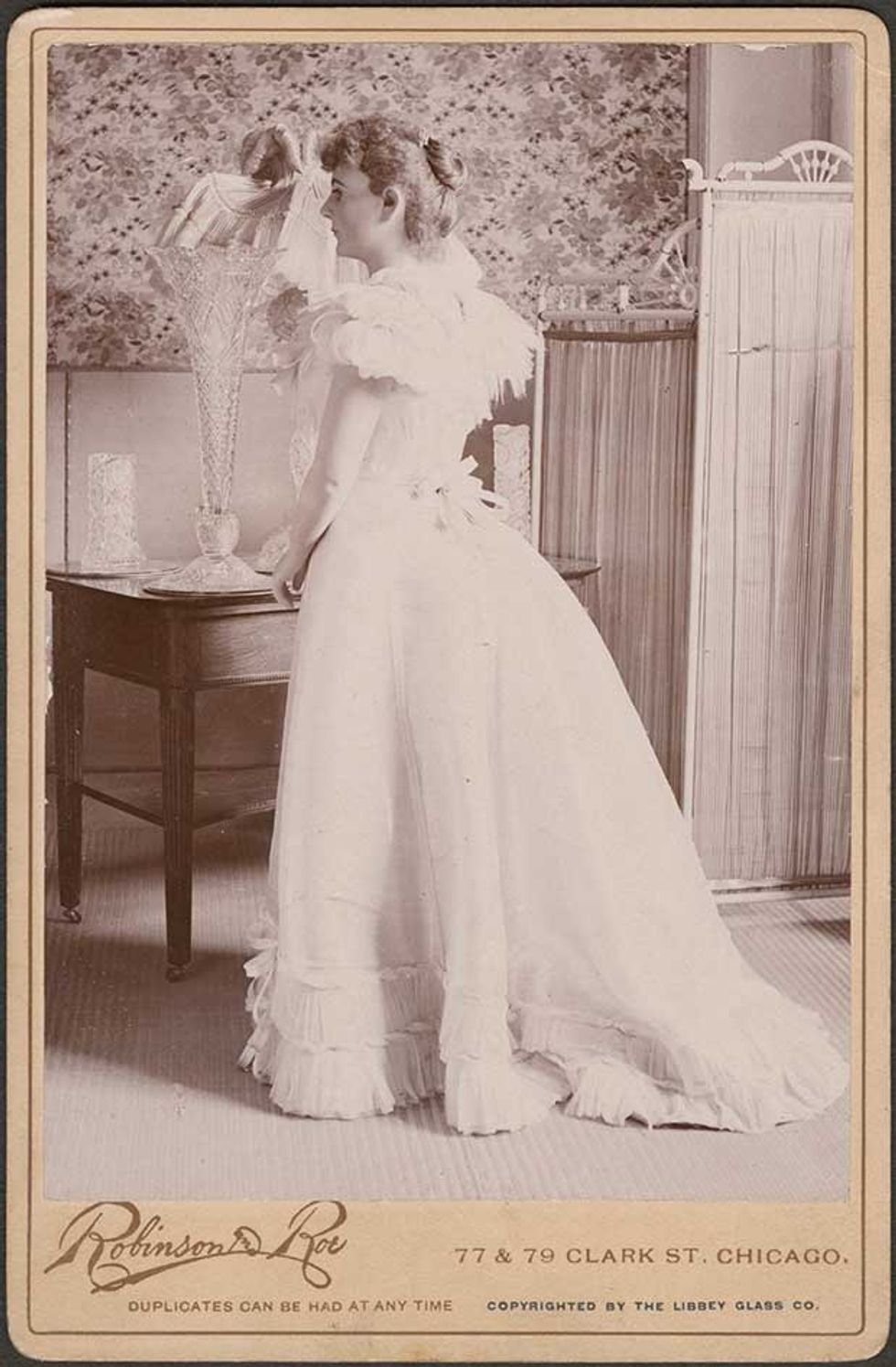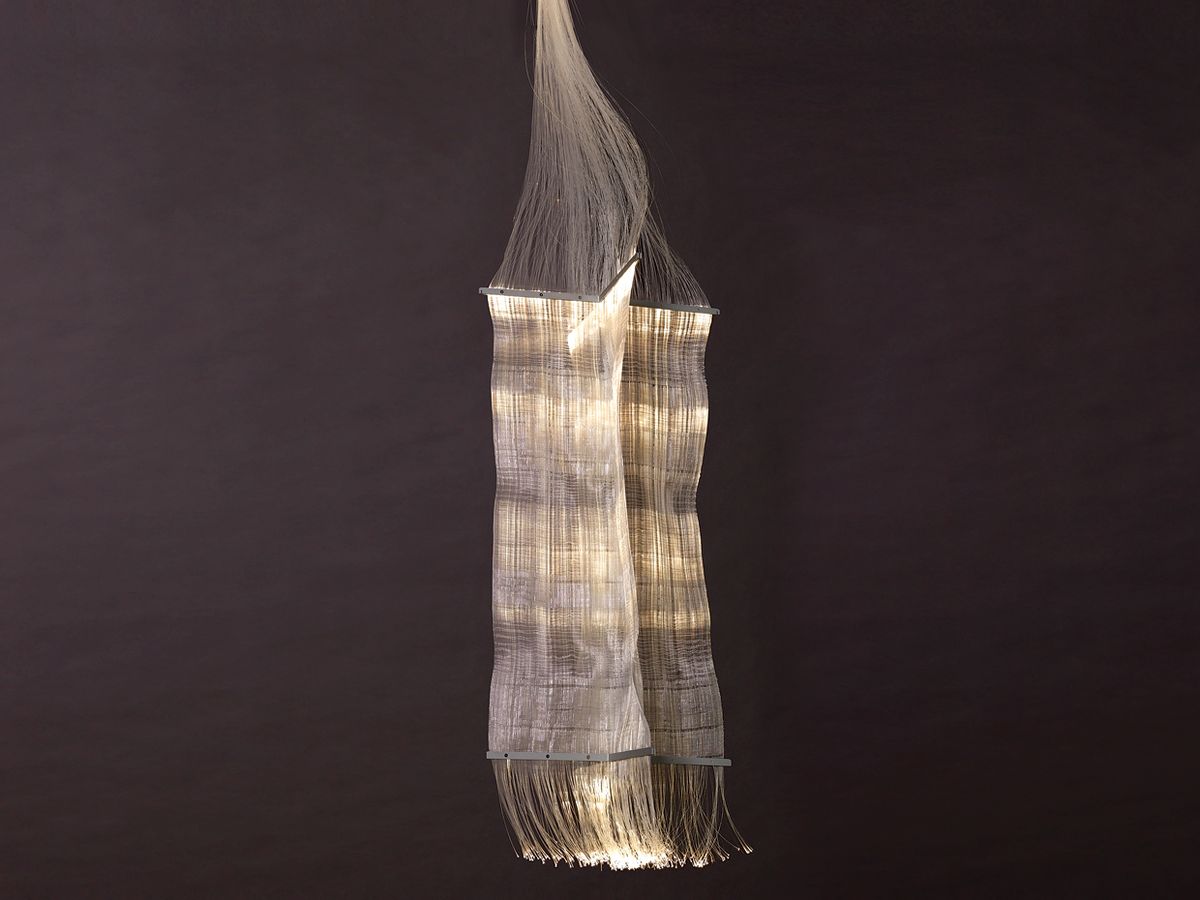“Whoopee!”So wrote Donald Keck, a researcher at Corning Glass Works, in the 7 August 1970 entry of his lab notebook. The object of his exuberance was a 29-meter-long piece of highly purified, titanium-doped optical fiber, through which he had successfully passed a light signal with a measured loss of only 17 decibels per kilometer. A few years earlier, typical losses had been closer to 1,000 dB/km. Keck’s experiment was the first demonstration of low-loss optical fiber for telecommunications, and it paved the way for transmitting voice, data, and video over long distances.
As important as this achievement was, it was not an isolated event. Physicists and engineers had been working for decades to make optical telecommunications possible, developing not just fibers but waveguides, lasers, and other components. (More on that in a bit.) And if you take the long view, as historians like me tend to do, it’s part of a fascinating tapestry that also encompasses glass, weaving, art, and fashion.
Optical fiber creates stunning effects in art and fashion
Shown above is a sculpture called Crossform Pendant Lamp, by the New York–based textile artist Suzanne Tick. Tick is known for incorporating unusual materials into her weaving: recycled dry cleaner hangers, Mylar balloons washed up on the beach, documents from her divorce. For the lamp, she used industrial fiber-optic yarn.

The piece was part of a collaboration between Tick and industrial designer Harry Allen. Allen worked on mounting ideas and illuminators, while Tick experimented with techniques to weave the relatively stiff fiber-optic yarn. (Optical fiber is flexible compared with other types of glass, but inflexible compared to, say, wool.) The designers had to determine how the lamp would hang and how it would connect to a power and light source. The result is an artwork that glows from within.
Weaving is of course an ancient technology, as is glassmaking. The ability to draw, or pull, glass into consistent fibers, on the other hand, emerged only at the end of the 19th century. As soon as it did, designers attempted to weave with glass, creating hats, neckties, shawls, and other garments.
Perhaps the most famous of these went on display at the 1893 World’s Columbian Exposition in Chicago. The exhibit mounted by the Libbey Glass Company, of Toledo, Ohio, showcased a dress made from silk and glass fibers. The effect was enchanting. According to one account, it captured the light and shimmered “as crusted snow in sunlight.” One admirer was Princess Eulalia of Spain, a royal celebrity of the day, who requested a similar dress be made for her. Libbey Glass was happy to oblige—and receive the substantial international press.
The glass fabric was too brittle for practical wear, which may explain why few such garments emerged over the years. But the idea of an illuminated dress did not fade, awaiting just the right technology. Designer Zac Posen found a stunning combination when he crafted a dress of organza, optical fiber, LEDs, and 30 tiny battery packs, for the actor Claire Danes to wear to the 2016 Met Gala. The theme of that year’s fashion extravaganza was “Manus x Machina: Fashion in an Age of Technology,” and Danes’s dress stole the show. Princess Eulalia would have approved.
Fiber optics has many founders
Of course, most of the work on fiber optics has occurred in the mainstream of science and engineering, with physicists and engineers experimenting with different ways to manipulate light and funnel it through glass fibers. Here, though, the history gets a bit tangled. Let’s consider the man credited with coining the term “fiber optics”: Narinder Singh Kapany.
Kapany was born in India in 1926, received his Ph.D. in optics from Imperial College London, and then moved to the United States, where he spent the bulk of his career as a businessman and entrepreneur. He began working with optical fibers during his graduate studies, trying to improve the quality of image transmission. He introduced the term and the field to a broader audience in the November 1960 issue of Scientific American with an article simply titled “Fiber Optics.”
#TBT 3 years ago exactly the first gown lighting test with @clairedanes for the #metgala #zacposen sparkleszap️
null
As Kapany informed his readers, a fiber-optic thread is a cylindrical glass fiber having a high index of refraction surrounded by a thin coating of glass with a low index of refraction. Near-total internal reflection takes place between the two, thus keeping a light signal from escaping its conductor. He explained how light transmitted along bundles of flexible glass fibers could transport optical images along torturous paths with useful outcomes. Kapany predicted that it would soon become routine for physicians to examine the inside of a patient’s body using a “fiberscope”—and indeed fiber-optic endoscopy is now commonplace.
Kapany’s article unintentionally introduced an extra loop into the historical thread of fiber optics. In an anecdote that leads off the article, Kapany relates that in the 1870s, Irish physicist John Tyndall demonstrated how light could travel along a curved path. His “light pipe” was formed by a stream of water emerging from a hole in the side of a tank. When Tyndall shone a light into the tank, the light followed the stream of water as it exited the tank and arced to the floor. This same effect is seen in illuminated fountains.
Kapany’s anecdote conjures a mental image that allows readers to begin to understand the concept of guiding light, and I always love when scientists evoke history. In this case, though, the history was wrong: Tyndall wasn’t the originator of the guided-light demonstration.
While researching his highly readable 1999 book City of Light: The Story of Fiber Optics, Jeff Hecht discovered that in fact Jean-Daniel Colladon deserves the credit. In 1841, the Swiss physicist performed the water-jet experiment in Geneva and published an account the following year in Comptes Rendus, the proceedings of the French Academy of Sciences. Hecht, a frequent contributor to IEEE Spectrum, concluded that Michael Faraday, Tyndall’s mentor, probably saw another Swiss physicist, Auguste de la Rive, demonstrate a water jet based on Colladon’s apparatus, and Faraday then encouraged Tyndall to attempt something similar back in London.
I forgive Kapany for not digging around in the archives, even if his anecdote did exaggerate Tyndall’s role in fiber optics. And sure, Tyndall should have credited Colladon, but then there is a long history of scientists not getting the credit they deserve. Indeed, Kapany himself is considered one of them. In 1999 Fortune magazine listed him as one of the “unsung heroes” of 20th-century businessmen. This idea was perpetuated after Kapany did not share the Nobel Prize in Physics with Charles Kao in 2009 for achievements in the transmission of light in fibers for optical communication.
Whether or not Kapany should have shared the prize—and there are never any winners when it comes to debates over overlooked Nobelists—Kao certainly deserved what he got. In 1963 Kao joined a team at Standard Telecommunication Laboratories (STL) in England, the research center for Standard Telephones and Cables. Working with George Hockham, he spent the next three years researching how to use fiber optics for long-distance communication, both audio and video.
On 27 January 1966, Kao demonstrated a short-distance optical waveguide at a meeting of the Institution of Electrical Engineers (IEE).
According to a press release from STL, the waveguide had “the information-carrying capacity of one Gigacycle, which is equivalent to 200 television channels or over 200,000 telephone channels.” Once the technology was perfected, the press release went on, a single undersea cable would be capable of transmitting large amounts of data from the Americas to Europe.
In July, Kao and Hockham published their work [PDF] in the Proceedings of the IEE. They proposed that fiber-optic communication over long distances would be viable, but only if an attenuation of less than 20 dB/km could be achieved. That’s when Corning got involved.
Corning’s contribution brought long-distance optical communication closer to reality
In 1966, the head of a new group in fiber-optic communication at the Post Office Research Station in London mentioned to a visitor from Corning the need for low-loss glass fibers to realize Kao’s vision of long-distance communication. Corning already made fiber optics for medical and military use, but those short pieces of cable had losses of approximately 1,000 dB/km—not even close to Kao and Hockham’s threshold.
That visitor from Corning, William Shaver, told his colleague Robert Maurer about the British effort, and Maurer in turn recruited Keck, Peter Schultz, and Frank Zimar to work on a better way of drawing the glass fibers. The group eventually settled on a process involving a titanium-doped core. The testing of each new iteration of fiber could take several months, but by 1970 the Corning team thought they had a workable technology. On 11 May 1970, they filed for two patents. The first was US3659915A, a fused silica optical waveguide, awarded to Maurer and Schultz, and the second was US271126A, a method of producing optical waveguide fibers, awarded to Keck and Schultz.
Three months after the filing, Keck recorded the jubilant note in his lab notebook. Alas, it was after 5:00 pm on a Friday, and no one was around to join in his celebration. Keck verified the result with a second test on 21 August 1970. In 2012, the achievement was recognized with an IEEE Milestone as a significant event in electrotechnology.
Of course, there was still much work to be done to make long-distance optical communication commercially viable. Just like Princess Eulalia’s dress, Corning’s titanium-doped fibers weren’t strong enough for practical use. Eventually, the team discovered a better process with germanium-doped fibers, which remain the industry standard to this day. A half-century after the first successful low-loss transmission, fiber-optic cables encircle the globe, transmitting terabits of data every second.
An abridged version of this article appears in the August 2020 print issue as “Weaving Light.”
Part of a continuing serieslooking at photographs of historical artifacts that embrace the boundless potential of technology.
About the Author
Allison Marsh is an associate professor of history at the University of South Carolina and codirector of the university’s Ann Johnson Institute for Science, Technology & Society.
Allison Marsh is a professor at the University of South Carolina and codirector of the university's Ann Johnson Institute for Science, Technology & Society. She combines her interests in engineering, history, and museum objects to write the Past Forward column, which tells the story of technology through historical artifacts.



